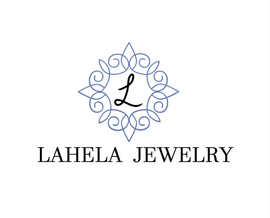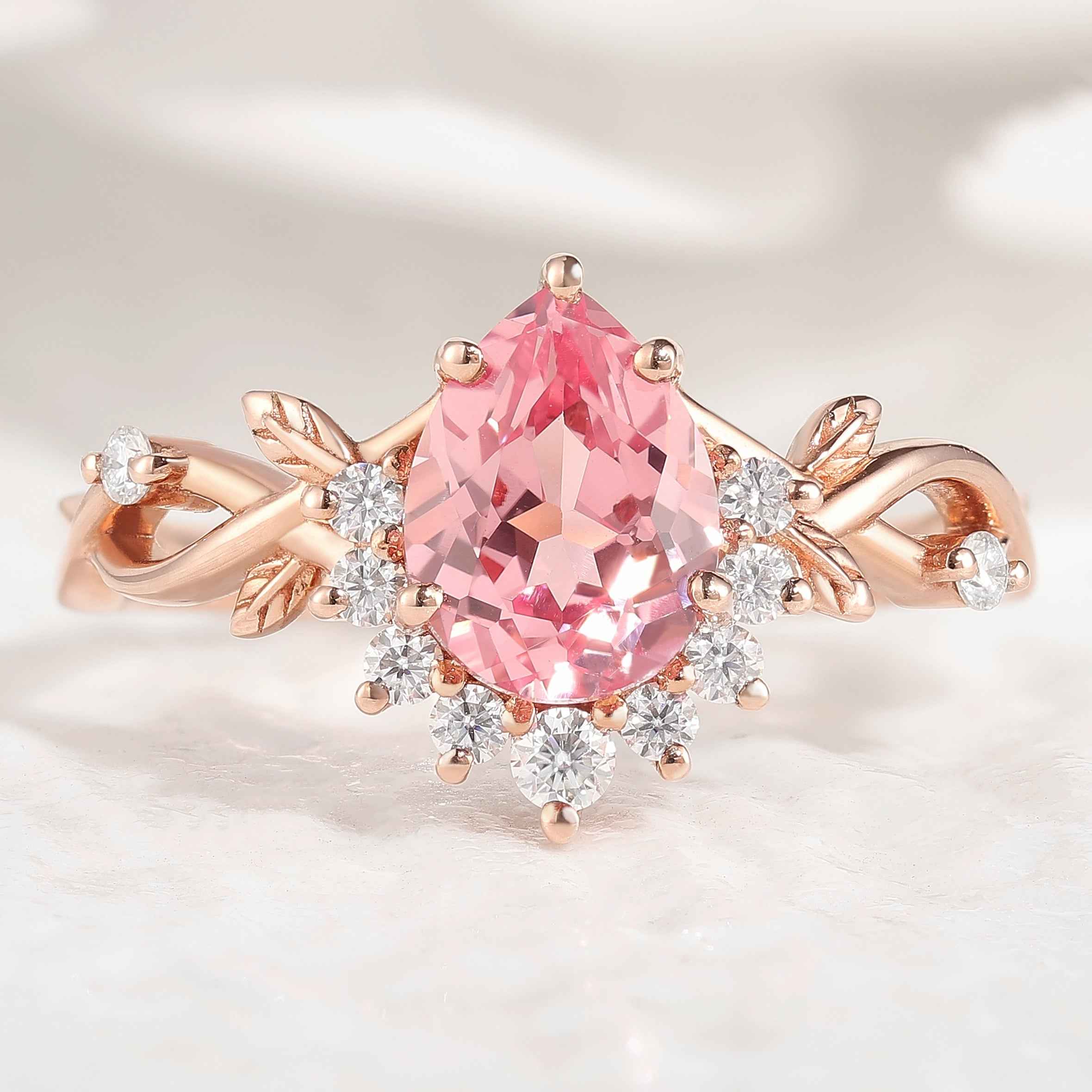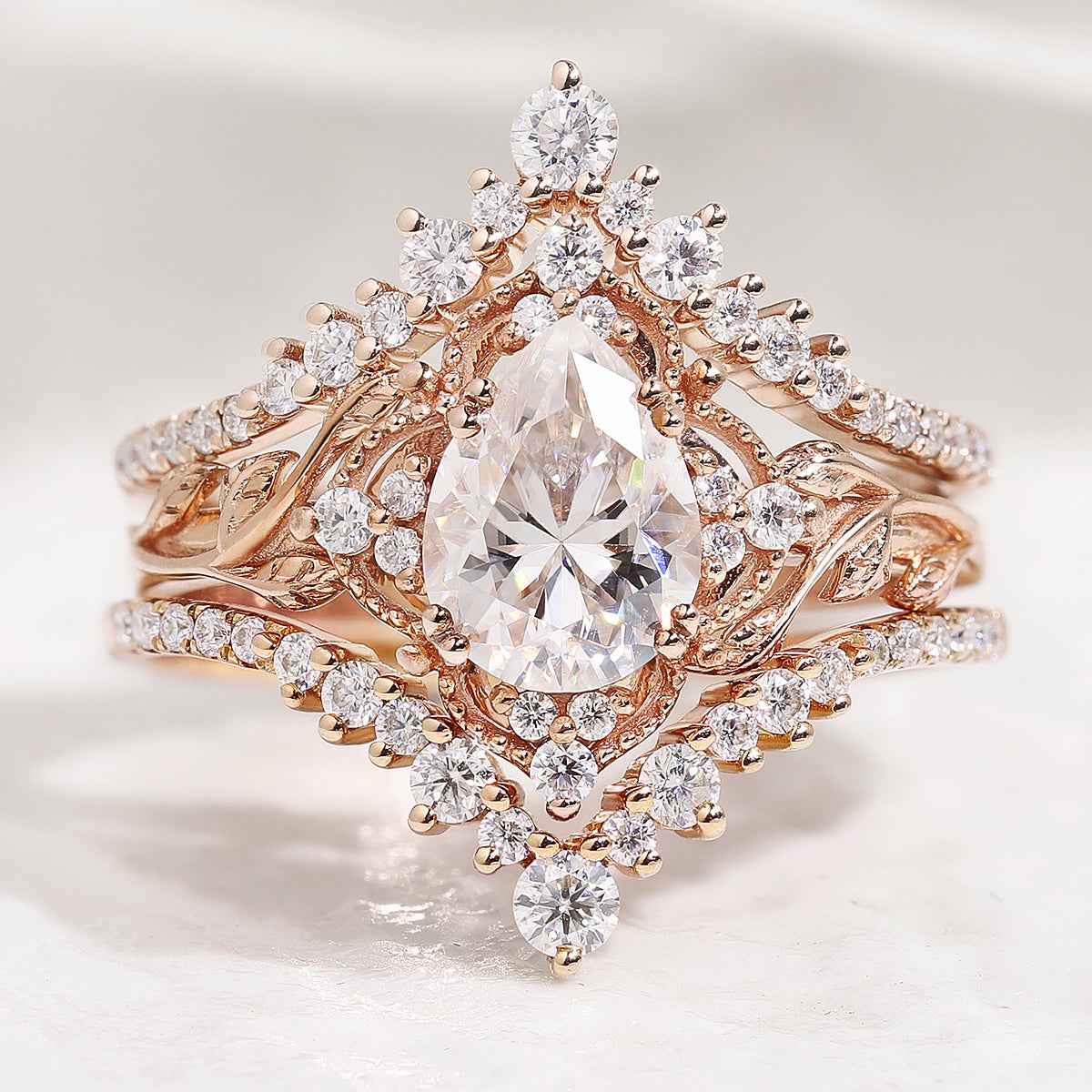In recent years, moissanite has become an increasingly popular choice for engagement rings. Couples are drawn to its dazzling sparkle, exceptional durability, and ethical, lab-created origin. Offering a stunning and affordable alternative to traditional diamonds, moissanite allows modern brides and grooms to celebrate their love with a gemstone that is both beautiful and conscious.

What Is Moissanite?
Moissanite is a dazzling, lab-created gemstone composed of silicon carbide, celebrated for its exceptional brilliance and durability. Originally discovered in 1893 by French chemist Henri Moissan in a meteor crater, natural moissanite is incredibly rare—so the gemstones used in jewelry today are created in laboratories. With a hardness of 9.25 on the Mohs scale and a refractive index higher than diamond, moissanite delivers extraordinary sparkle and long-lasting strength. Loved for its eco-friendly origin and affordable luxury, moissanite engagement rings offer a sustainable alternative to traditional diamond rings.
Is Moissanite a Real Diamond?
While moissanite and diamond may look similar to the naked eye, they are entirely different gemstones. A diamond is made of pure carbon, formed deep within the earth over billions of years, while moissanite is composed of silicon carbide and created in controlled laboratory conditions. Moissanite is not a fake diamond—it’s a unique gemstone in its own right, admired for its fire, brilliance, and ethical sourcing. Though both share exceptional hardness and beauty, moissanite’s colorful sparkle and affordable price make it a popular choice among modern couples who value both elegance and sustainability.
Moissanite vs. Diamond: Key Differences Explained
| Feature | Moissanite | Diamond |
| Composition | Silicon Carbide | Pure Carbon |
| Origin | Lab-created | Natural or Lab-grown |
| Hardness (Mohs Scale) | 9.25 | 10 |
| Brilliance & Fire | Higher refractive index; More colorful sparkle | Classic white sparkle; More subdued |
| Color | Colorless to near-colorless (may show slight yellow/green tint) | D (colorless) to Z (light yellow/brown) |
| Clarity | Typically eye-clean | Varies (may have natural inclusions) |
| Cost | 20-50% less expensive | Higher price point |
| Value Over Time | Doesn't appreciate | May appreciate in value (natural) |
| Environmental Impact | Eco-friendly (lab-created) | Varies (mining impact for natural) |
| Best For |
• Budget-conscious buyers • Ethical shoppers • Those who love extra sparkle • Practical romantics |
• Traditionalists • Luxury enthusiasts • Investment-minded buyers • Durability seekers |
Composition and Origin
Moissanite and diamond are two distinct gemstones with varied chemical composition. Moissanite consists of silicon carbide, whereas diamonds consist of pure carbon. atural diamonds are formed way below the Earth's surface over millions of years, but most moissanite used in jewelry is lab-created. Lab-grown diamonds, on the other hand, are chemically identical to natural diamonds but produced in controlled environments.
Brilliance and Fire
Perhaps the most obvious variation between moissanite and diamond comparisons is their optical properties. Moissanite has a greater refractive index than diamonds, producing more fire and brilliance. This means moissanite engagement rings will show more colorful light explosions compared to diamond rings. But some prefer the understated sparkle of diamonds for its timeless appeal.
Hardness and Durability
When looking at women's moissanite rings or diamond rings to be worn every day, durability is important. Diamonds are rated 10 on the Mohs scale of hardness, which means they are the hardest natural material. Moissanite is close behind with a rating of 9.25, being very scratch-resistant and ideal for everyday wear. Both the stones make great engagement ring choices as they are very durable.
Color and Clarity
Modern moissanite is available in a range of colors like white diamonds, ranging from near-colorless to completely colorless. However, there will be some moissanite that show a faint yellow or greenish tint under certain lighting conditions. Diamonds are rated from D (colorless) to Z (light yellow or brown). As for clarity, synthetic moissanite is typically eye-clean, while natural diamonds may have visible blemish.
Cost
Price is perhaps one of the largest moissanite diamond difference. Moissanite is significantly less expensive than diamonds, typically costing 20% to 50% less for comparable size and quality. This makes moissanite engagement rings vs diamond engagement rings a tempting option for budget-conscious couples seeking a beautiful and durable engagement ring.
Ethical and Environmental Considerations
Some couples choose moissanite wedding rings or cultured diamonds on ethical considerations. Both of them are manufactured in a controlled laboratory environment, avoiding the environmental and social problems associated with diamond mining. This allows couples to commemorate their love while having a clear conscience, knowing their choice is eco-friendly and conflict-free.
Couples can make a well-informed decision that suits their values, lifestyle, and budget by knowing these important differences between moissanite and diamonds.

It is a big deal to choose the ideal stone for an engagement ring. Popular choices include moissanite and diamond, both of which have their own set of advantages. In contrast to diamonds' classic beauty and long-lasting luster, moissanite sparkles with inexpensive brilliance. Let's talk about your tastes and see which stone would work best.
Who Might Like Diamond Engagement Rings?
Diamonds are ideal for those who enjoy tradition and the symbolism of this long-standing gemstone. The following individuals might prefer diamond rings:
- Traditional Romantic. Diamonds have long symbolized eternal love and devotion, and those who value traditional romance symbols will love them.
- Durability Seekers. Diamonds are the hardest natural material, ranking 10 on the Mohs scale, meaning they are perfect for those who desire ultimate scratch resistance and long-time durability.
- Luxury Enthusiasts. Diamonds are also used as a symbol of status, and individuals who value luxury and uniqueness might find diamond rings appealing.
- Investment-Minded Buyers. Natural diamonds increase in value over time, so they're an investment for some buyers.
Who Should Consider Moissanite Engagement Rings?
Moissanite brings the attributes of brilliance, affordability, and ethical appeal, so that it can fit into the below groups:
- Budget-Saving Couples. Moissanite is much cheaper than diamonds as mentioned earlier, which makes moissanite rings a very good option for those with tight budgets. Remember though - the true value of an engagement ring isn't measured by its price tag, but by the love and commitment it represents.
- Ethical Buyers. Moissanite is created in a lab, avoiding any possible social and environmental issues from diamond mining. This will find favor with buyers who appreciate ethical and green shopping.
- Fans of Brilliance. Moissanite boasts a higher refractive index than diamonds, providing moissanite with added brilliance and fire. So, moissanite wedding rings are ideal for those who appreciate extra sparkle.
- Practical Romantics. Those who want a balance of romance and practicality might find moissanite rings over diamond rings. Moissanite offers similar beauty and durability to diamonds but at a lower cost.
Frequently Asked Questions About Moissanite and Diamond
Q: How does moissanite perform in changing light conditions as compared to diamonds?
Moissanite and diamonds may appear slightly different under varying lighting conditions. Both gemstones shine brightly under daylight. Under artificial light, however, moissanite may have more colorful flashes than diamonds. Diamonds will retain their white sparkle in dim light, but moissanite may appear slightly darker.
Q: Can moissanite be used in every type of jewelry setting?
Yes, moissanite is versatile and can be used in almost any jewelry setting style that diamonds can. This includes halo, three-stone, solitaire, and pavé settings. Moissanite's hardness makes it appropriate for delicate as well as sturdy designs.
Q: Are there any special care instructions for moissanite rings?
Although moissanite is durable, it still requires maintenance. Clean your moissanite ring regularly with warm water and mild soap, and use a soft brush if needed. Never expose the ring to harsh chemicals or ultrasonic cleaners as they can destroy the setting. It's also advisable to remove the ring when engaging in activities that may subject it to hard blows.
Q: How does the value of moissanite hold up over time compared to that of diamonds?
Unlike natural diamonds, which appreciate in value, moissanite doesn't increase in value over time. Its durability, however, ensures that it will remain a symbol of beauty and sparkle for decades to come, delivering immense value on the initial investment.
Q: How can you differentiate moissanite from diamond?
Distinguishing between moissanite and diamond requires some expertise. A few methods include:
- Visual Inspection. Put the gemstone under a jeweler's loupe and observe it at an angle. Double refraction is typical in moissanite, which manifests as a doubling effect, something that diamonds lack.
- Electrical Conductivity Test. Moissanite is conductive, whereas diamonds are not. Specialized testers can detect this difference.
- Thermal Conductivity Test. Moissanite is more thermally conductive than diamonds. Thermal conductivity probes can be used to measure this.
- UV Light Test. Diamonds will typically fluoresce when exposed to UV light, while moissanite will not or show some other color glow.





